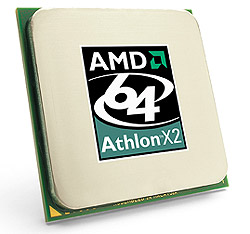Hyperthreading was Intel's pre-emptive take on
multi-core CPUs. The company cloned
the front end of its high-end Pentium 4 CPUs, allowing the Pentium 4-HT to
begin two operations at once. Once in process, the twin operation 'threads'
both share the same set of execution resources, but one thread
can take advantage of sections left idle by the other.
The idea of Hyperthreading is to double the amount of activity in the chip in
order to reduce the problem of 'missed' memory cache requests slowing down the
operation of the processor. It also theoretically ensures that less of the
processor's resources will be left idle at any given time.
While Hyperthreaded CPUs appear as two logical processors to most operating
systems, they are not comparable with true dual-core CPUs since each parallel
pair of threads being worked on share the same execution pipeline and same set
of L1 and L2 cache memory. Essentially, Hyperthreading is smoke-and-mirrors
multitasking, since a single Hyperthreaded processor cannot actually perform two
identical actions at the same time.
Hyperthreading does speed up certain operations which would be
multi-processor capable, but never as much as a true multi-processor system,
dual core or not.
One of Intel's new dual-core chips, the higher-end Pentium Extreme Edition
840 processor, also support Hyperthreading within each core, meaning that to an
operating system it would appear as four logical processors on a single
die. How this will work out remains to be seen.
Two Chips on One Die… Why?
 So why are both Intel and AMD suddenly peddling
dual-core pushcarts so quickly down the aisle?
So why are both Intel and AMD suddenly peddling
dual-core pushcarts so quickly down the aisle?
Several reasons; first of all; competition, competition, competition. As we will
explore later in more detail, AMD built the potential for dual-core capability into its 64-bit processors right
from the start. The necessary I/O structure for the second core already
exists, even on single core chips. Neither company can afford to let the
other get much of an edge, and AMD has already stolen way too
much attention for Intel's comfort with its incredibly successful line of 64-bit
processors.
It is imperative
for Intel to launch a 'pre-emptive strike' and get its own dual-core technology
to market quickly, lest marketshare flutter away. As for why dual core processors are
being developed in the first place, read on to reason number
three.
Secondly, performance. Certain
'multi-threaded' applications can already benefit greatly by allowing more than one
processor to work on them at once. Dual processor systems also gain from a general
decline in latency. Simply put, while there is no current way to share
the current operating system load evenly between two processors, the second processor
can step in and keep the system running smoothly while the first
is maxed out to 100% burning a CD or encoding a file (or
from a software error).
Obviously, if dual-core systems become
mainstream, which it looks like they are going to, future operating systems
and applications will be designed with the feature in mind, leading to better
functionality down the road.
Thirdly, and
less obviously, AMD and Intel are desperate. Both companies have run into barriers when it comes
to increasing the raw speed of processors, or decreasing the die size.
Until these roadblocks are cleared or until the general buying public
understands that GHz does not directly translate to performance, both companies will be
scrambling to discover any new improvements that will improve processor performance... without actually boosting core
speed. This is why the idea of dual-core processors is now a reality, I'm
willing to bet.
